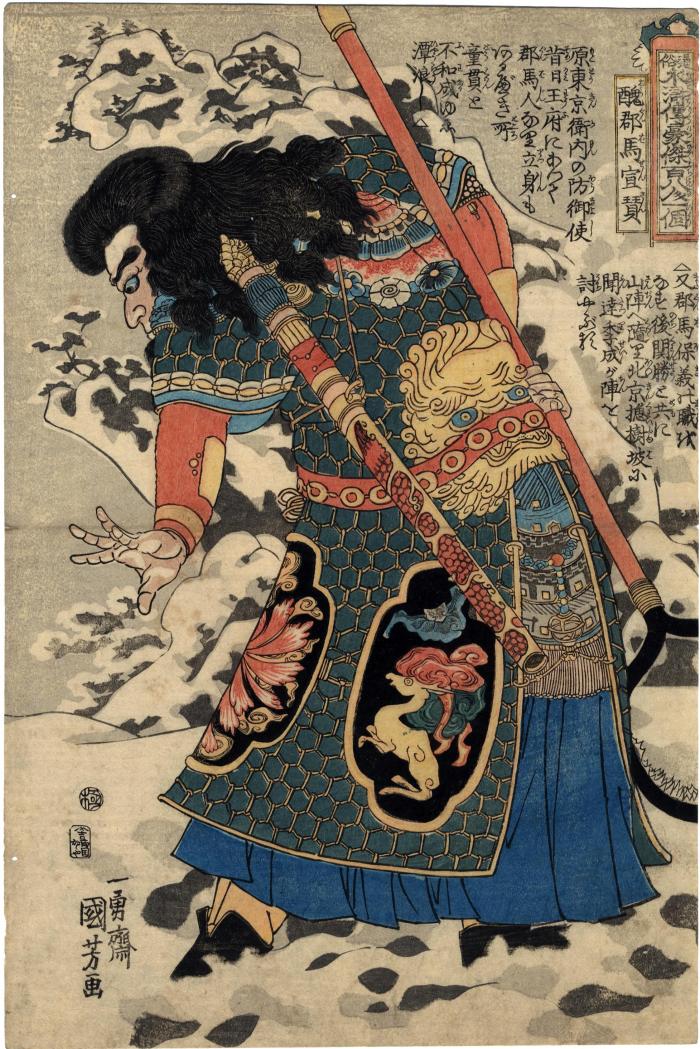Utagawa Kuniyoshi (歌川国芳) (artist 11/15/1797 – 03/05/1861)
Xuan Zan, the Ugly Son-in-Law (Shūgunba Sensan - 醜郡馬宣贊) from the series One Hundred and Eight Heroes of the Popular Shuihuzhuan (Tsūzoku Suikoden gōketsu hyakuhachinin no hitori - 通俗水滸傳濠傑百八人一個)
1827 – 1830
9.75 in x 14.5 in (Overall dimensions) Japanese woodblock print
Signed: Ichiyūsai Kuniyoshi ga
一勇斎国芳画
Publisher: Kagaya Kichiemon
(Marks 195 - seal 22-025)
Censor's seal: kiwame
British Museum
Tokyo National Museum
Museum of Fine Arts, Boston - print of Guan Sheng mentioned in the text below
Ishikawa Prefectural Museum of Art
Nationaal Museum van Wereldculturen (Rijksmuseum Volkenkunde, Leiden) via Ritsumeikan University
Lyon Collection - another copy of this print The Ugly Son-in-Law is first mentioned on pages 1029-30 in Chapter 63 of the story of the marsh bandits.
"We need a plan, and a first-rate general, to drive off the marauding bandits and preserve the city,"...****
The assembled officers looked at one another with frightened expressions. From behind the infantry marshal a man stepped forward. A commander of the palace guards, his name was Xuan Zan. His face was as black as the bottom of [a] pot, his nostrils were aimed at he sky, he had curly hair and a reddish beard. A massive fellow, he wielded a steel blade. His skill with weapons was out of the ordinary. Formerly married to the daughter of a prince, he had been known as the Ugly Son-in-Law. The prince, impressed by his winning several archery matches in a row, had given him his daughter in marriage. But Xuan Zan's ugliness had so revolted the girl that she died.
As a result he was held in low esteem and never rose above his rank of guards' commander. Tong Guan, a wily sycophant and courier, considered himself infinitely superior, and treated him with contempt.
But at this moment Xuan Zan felt he had to speak, and he addressed the premier.
"I became friends with a man when I was in the rural areas. His is a direct descendant of Guan Yu, famed general at the end of the Han Dynasty, when the country split into three. His name is Guan Sheng, and he bears a striking resemblance to his noble ancestor. His weapon is a crescent-shaped halberd, and so people call him Guan Sheng the Big Halberd. He is now a lowly patrol officer in Pudong, but he's studied books of military lore since childhood, is thoroughly versed in weaponry, and is a man of matchless valor. If he is presented with money and raised to senior officer rank, he can expunge the water-girt fortress and destroy the wild rebels. This man is essential to the preservation of our country and peace in our land. He awaits only your command."
Shūgunba Sensan, #44 in Klompmakers' book, is armored, but bare-headed in the snow, carrying a pole with a large, barbed ring at the end of it.
Sensan, like many of the figures in the Suikoden, starts out as an imperial commander sent against the gang of bandits. However, he is defeated by a female warrior and he then changes sides.
In a plot to rescue two captured members of the gang Sensan takes part in an attack on Beijing during the Festival of the Lanterns. In this print Sensan is shown standing in wait in the snow outside the city waiting to capture or destroy fleeing enemies.
If you look closely you will see three propitious symbols in the panel decorating the bottom of Sensan's protective armor: a blue bat, a kylin (麒麟) and a ju-i (如意) fungus which appears to be walking.
****
Klompmakers wrote: "Shūgunba Sensan commands both the infantry and cavalry of the imperial forces. His face is jet black; he has a turned-up nose and a red beard. In chapter 62 the emperor dispatches Sensan, along with Dairō Kanshō... and Seibokukan Kakushibun, to overthrow the Ryōsanpaku gang. Unsuccessful, Sensan is then captured by the female warrior Boyasha Sennijō... in chapter 63. Hereafter this commander of the imperial troops decides to become a leader in the Ryōsanpaku band as they make preparations to liberate Gyokukin Roshbungi... and Henmeisarō Seikishū... This rescue mission takes place during the annual Feast of lanterns [sic?] in Peking. After Roshungi and Sekishū's release, the brigands reduce a great portion of Peking to ashes."
"This print shows Sensan watching the snowy surroundings of Peking during the feast. Poised with his barbed ring on apole, he is probably waiting to catch fleeing enemy soldiers. Robinson believes that Sensan and Boyasha Sonnijō are part of a pentaptych including the images of Tenmokushō Hōki, Kyūsenpō Sakuchō and Seibokukan Kakushibun... (...respectively). The backgrounds of the Sensan and Sennijō prints, however, do not match the other prints which together clearly form a triptych. Suzuki maintains that the prints of Sensan and Sonnijō are a diptych, but the same argument, i.e., the mismatching backgrounds, can also be used to refute this. Furthermore, the design of Sennijō is such a solitary composition that it is difficult to conceive of it as part of a larger composition. As a diptych, the images of Sensan and Sennijō would differ considerably from other such examples in this series, which we are characterised by balanced and rather symmetrical compositions."
Quoted from Of Brigands and Bravery: Kuniyoshi's Heroes of the Suikoden by Inge Klompmakers, page 144.
****
The text reads: 原東京右衛内の防御使 昔日王府にあつて郡馬人なり 立身もあるべき所童貫と不和成ゆゑ漂浪し又郡馬保義の職をなす 後関勝と共に山陣へ随り 北京槐樹坡に聞達季成が陣を討やぶる
****
Illustrated in a full-page in a color reproduction in Of Brigands and Bravery: Kuniyoshi's Heroes of the Suikoden by Inge Klompmakers, Hotei Publishing, 1998, #44, page 145.
Kagaya Kichiemon (加賀屋吉右衛門) (publisher)
Suikoden (水滸傳) (genre)
bats (komori - 蝙蝠) (genre)
